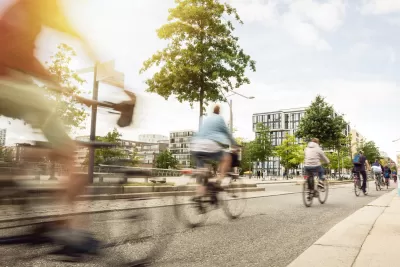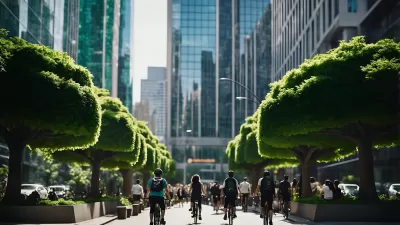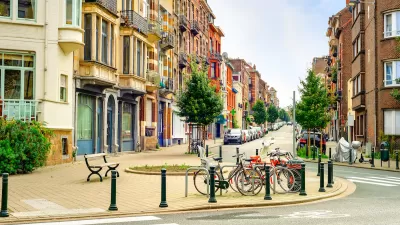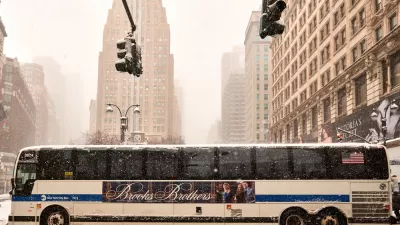Instead of aiming to make cities better for bikes, a new book argues we should be making cities better with bikes using a car-lite, not a car-free approach.

Just in time for Bike Month, a new book is hitting shelves that highlights the opportunities to remake American cities into better, more prosperous places through a focus on creating bikeable communities. Dan Piatkowski, PhD, wrote Bicycle City: Riding the Bike Boom to a Brighter Future after moving with his family from Lincoln, Nebraska, to Oslo, Norway. His shift from a very car-dominant culture to a bike-dominant culture showed the stark contrasts in the approach to transportation in American cities. “Throughout the ups and downs of daily life in a new and foreign place, I inevitably make comparisons with home, both good and bad,” he said in a recent Booked on Planning podcast interview.
Those comparisons helped him define a new term, car-lite cities, rather than a more dominant car-free approach. When asked how the term has been received, Piatkowski revealed that it was yet untested, and the book was its first use. He likes the term car-lite because “it’s just realistic, it's accurate, an honest description” because anyone working in transportation knows that terms like car-free can upset the public quickly. Instead of taking cars away completely, diminishing their importance and making room for options for traveling—whether by car, bike, walking, or transit—allows for options that make sense for all residents of a community. Midwest cities like Lincoln, Nebraska, do not have nearly enough density to forgo cars altogether. They do, however, have immense opportunities to drive up rates of bicycle commuting like Minneapolis has done over the past decade.
Shifting priorities
We have such a car dominated culture in the United States. Often the conversation is about how to move as quickly and cheaply as possible, which the engineering profession generally believes is via motor vehicle. That approach, embedded in the field of transportation, ignores that people need and want choices and that how we choose to travel is a more complex decision. Piatkowski and his car-lite ethos argue that we need to change the way we determine the success and failure of a roadway. The traditional A through F rating given to a street based on its ability to allow free-flow speed should be altered to account for its ability to accommodate more types of users such as transit, which has dozens more passengers in the same space as a single-occupancy vehicle, or bike lanes, which take up less space than a vehicle with the opportunity to move just as many travelers.
The COVID19 pandemic showed us that we can change fast when the need arises. Our communities created miles of slow and open streets, opened outdoor seating in parking spaces, and remade the public realm into areas where residents could gather and move about without safety concerns. Climate change is yet another major threat to our lives with each year breaking records for the hottest year and the financial toll rising because of increased natural disasters. We should be drastically rethinking our transportation systems, a sector accounting for 30 percent of greenhouse gas emissions, in an equally rapid manner, but we haven’t seen the same quick action yet.
Where there is a will, there is way
Piatkowski wrote the book because he was not sure whether cities could change really quickly, and through his research, he confirmed they could, given the right circumstances and political will. Effective organizing and effective advocacy are key to effecting change. The will is there to change, whether that is to support climate action or to increase the bikeability of a community, but it needs to be effectively channeled, as all of us have busy daily lives. Working as a transportation planner in Lincoln, Nebraska, I notice the bicyclists around the community, track the metrics with trail counters and Strava Metro, and hear the stories from individuals who want to bike but need more protected infrastructure. Unfortunately, without a coordinated advocacy campaign, the message is lost among the car-dominated demands for adding lanes and maintaining pavement, leaving little to no funding for building better pedestrian or bicycle infrastructure that supports the kinds of vibrant communities many of us travel overseas to get a glimpse of on vacation.
When we start designing bicycle cities, we open the door to creating communities full of options for how we travel. It is not quick or easy work, but—to pull a quote from Bicycle City— “it never gets easier, you just get faster.” The work to build a bicycle city is hard, filled with technical and political challenges. However, as Oslo showed, all you need is one political win to set the pendulum swinging in the right direction. Once that happens, cities can build on the momentum to move into a car-lite future that reflects the unique community values.
Stephanie Rouse, AICP is a transportation planner for the City of Lincoln, Nebraska, working to promote active transportation initiatives. She is also the co-host of the Booked on Planning podcast, where she interviews authors on a diverse range of topics such as equity, housing, transportation, technology, and sustainability.
Interested in purchasing Bicycle City: Riding the Bike Boom to a Brighter Future? Use discount code PLANETIZEN on Island Press's website to 20 percent off the purchase price.

Study: Maui’s Plan to Convert Vacation Rentals to Long-Term Housing Could Cause Nearly $1 Billion Economic Loss
The plan would reduce visitor accommodation by 25,% resulting in 1,900 jobs lost.

North Texas Transit Leaders Tout Benefits of TOD for Growing Region
At a summit focused on transit-oriented development, policymakers discussed how North Texas’ expanded light rail system can serve as a tool for economic growth.

Why Should We Subsidize Public Transportation?
Many public transit agencies face financial stress due to rising costs, declining fare revenue, and declining subsidies. Transit advocates must provide a strong business case for increasing public transit funding.

How to Make US Trains Faster
Changes to boarding platforms and a switch to electric trains could improve U.S. passenger rail service without the added cost of high-speed rail.

Columbia’s Revitalized ‘Loop’ Is a Hub for Local Entrepreneurs
A focus on small businesses is helping a commercial corridor in Columbia, Missouri thrive.

Invasive Insect Threatens Minnesota’s Ash Forests
The Emerald Ash Borer is a rapidly spreading invasive pest threatening Minnesota’s ash trees, and homeowners are encouraged to plant diverse replacement species, avoid moving ash firewood, and monitor for signs of infestation.
Urban Design for Planners 1: Software Tools
This six-course series explores essential urban design concepts using open source software and equips planners with the tools they need to participate fully in the urban design process.
Planning for Universal Design
Learn the tools for implementing Universal Design in planning regulations.
City of Santa Clarita
Ascent Environmental
Institute for Housing and Urban Development Studies (IHS)
City of Grandview
Harvard GSD Executive Education
Toledo-Lucas County Plan Commissions
Salt Lake City
NYU Wagner Graduate School of Public Service





























